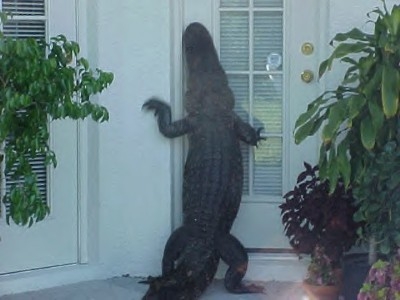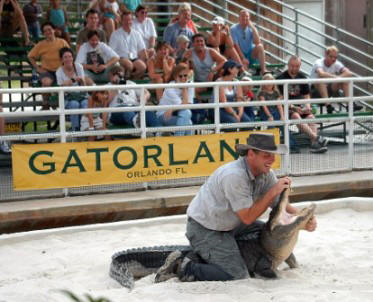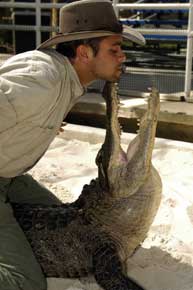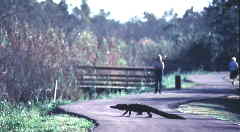
March 15, 2008

In the quest for cryptids, various lines of inquiry usually are pursued to discover the realm of mundane observations that may have been converted into the extraordinary. Today, I look at the role of crocodilians, especially the American alligator, in any confusion with Pinky.
Since coming to Florida, including observations this year, I’ve now viewed hundreds of individual alligators. In the Everglades in the 1970s, I saw American crocodiles in the wild too.
This year during this Pinky expedition, I’ve watched many gators in the early morning ~ resting and warming up to actively feed later. Along the St. Johns River, alligators have been plentiful and frequent non-violent encounters happened. (Well, there was that one female that didn’t want any people close to her babies, but that made sense.)
On land, crocodilians in general, including alligators, of course, can move about dragging their tails, or they can walk on their toes with heels of the hind feet and most of the tail well off the ground. Using this “high walk” alligators can run up to 30 miles per hour (38 kph) for short distances, and scare folks who stumble across them in the reeds and such.
But can running alligators be mistaken for bipedal dinosaurs?
Even though I’ve seen high-walking gators before and like most people watched the behavior in documentaries, I wanted to concentrate a bit on watching some in captivity.

In Florida, humans and alligators have a strange co-existence. Humans now live where gators use to freely roam. It is predictable that alligators would find neighborhood dogs as easy snacks and people’s pools as inviting swimming holes. In rarer cases, the alligators even try to make house calls (below).

But city folks’ interventions often call for these animals to be destroyed or relocated. The lucky ones come to places like Gatorland.
Along with some research associates, I ventured to Gatorland on Friday, March 14, 2008.

The gator wrestling aside, which actually served as a subtle way for the visitors to be educated on alligator biology, Gatorland houses quite a good collection of animals – crocodiles, alligators, snakes, turtles, and birds.
Due to the fact it was created in 1949, and the surrounding urban tourist sprawl has sprang up since then, this 110 acres of prime wetland is today a significant bird sanctuary. Many large species of egrets, herons, vultures, and other birds breed and nest here, on low-hanging trees above the captive alligator marshes. Bobcat, wild ones, live within the grounds of Gatorland.
The place was dotted with what appeared to be professional bird photographers on the boardwalks, who were taking pictures of birds only a few feet away.

I was interested in closely examining the examples of high-walking I saw, and the gators thrashing about the water. No way did these look like dinos, or anything other than a gator or a very mobile log.
Although to support itself, Gatorland does have to be commercial, it was mostly a straightforward animal collection. Other than the interactions between the gift shop’s Dee and Nancy with my purchase point man Evan (who was there with wife Marcia, daughter Elizabeth, and friend Sue), to obtain an alligator head that will soon be in the International Cryptozoology Museum, you could easily ignore that end of things.

It might be romantically attractive to think of high-walking alligators as the best candidates for their kin, the dinosaurs, in the form of Pinky, but firsthand observations, once again, convinced me otherwise.
An out-of-place American croc or a near-albino gator seems an unlikely candidate for the Lake Monroe Monster, the St. Johns River Monster, or Pinky.
My expedition into the wilds of Florida ends in the next 48 hours, and I fly back to winterland in Maine. I’ll share some concluding thoughts on Monday or Tuesday.
I’ll miss the swamps.
About Loren Coleman
Loren Coleman is one of the world’s leading cryptozoologists, some say “the” leading living cryptozoologist. Certainly, he is acknowledged as the current living American researcher and writer who has most popularized cryptozoology in the late 20th and early 21st centuries.
Starting his fieldwork and investigations in 1960, after traveling and trekking extensively in pursuit of cryptozoological mysteries, Coleman began writing to share his experiences in 1969. An honorary member of Ivan T. Sanderson’s Society for the Investigation of the Unexplained in the 1970s, Coleman has been bestowed with similar honorary memberships of the North Idaho College Cryptozoology Club in 1983, and in subsequent years, that of the British Columbia Scientific Cryptozoology Club, CryptoSafari International, and other international organizations. He was also a Life Member and Benefactor of the International Society of Cryptozoology (now-defunct).
Loren Coleman’s daily blog, as a member of the Cryptomundo Team, served as an ongoing avenue of communication for the ever-growing body of cryptozoo news from 2005 through 2013. He returned as an infrequent contributor beginning Halloween week of 2015.
Coleman is the founder in 2003, and current director of the International Cryptozoology Museum in Portland, Maine.
Filed under Breaking News, Cryptomundo Exclusive, Cryptotourism, CryptoZoo News, Cryptozoologists, Cryptozoology, Expedition Reports, Living Dinosaurs, Mokele-Mbembe